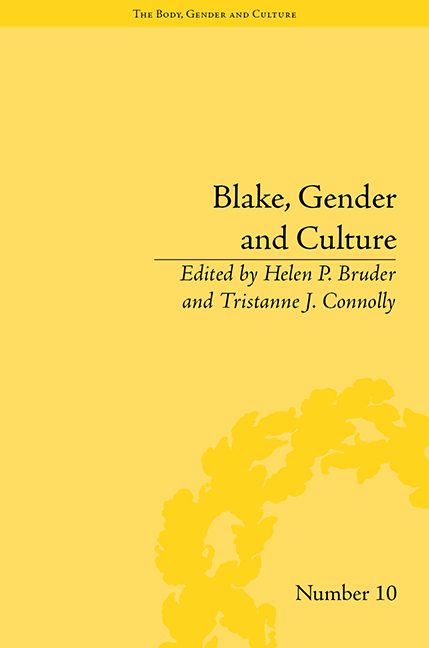Book contents
- Frontmatter
- CONTENTS
- Acknowledgements
- List of Contributors
- List of Figures
- Abbreviations
- Introduction: Naked History Displayed
- 1 ‘Merely a Superior Being’: Blake and the Creations of Eve
- 2 The Last Strumpet: Harlotry and Hermaphroditism in Blake's Rahab
- 3 Sex, Violence and the History of this World: Blake's Illustrations to the Book of Enoch
- 4 Bridal Mysticism and ‘Sifting Time’: The Lost Moravian History of Blake's Family
- 5 ‘A Secret Common to Our Blood’: The Visionary Erotic Heritage of Blake, Thomas Butts and Mary Butts
- 6 Changing the Sexual Garments: The Regeneration of Sexuality in Jerusalem
- 7 Philoprogenitive Blake
- 8 ‘Seeking Flowers to Comfort Her’: Queer Botany in Blake's Visions, Darwin's Loves and Wollstonecraft's Rights of Woman
- 9 ‘Or Wilt Thou Go Ask the Mole?’: (Con)Figuring the Feminine in Blake's Thel
- 10 Gendering the Margins of Gray: Blake, Classical Visual Culture and the Alternative Bodies of Ann Flaxman's Book
- 11 The Virgil Woodcuts Out of Scale: Blake's Gigantic, Masculine Pastoral
- 12 Closet Drama: Gender and Performance in Blake and Joanna Baillie
- Notes
- Works Cited
- Index
1 - ‘Merely a Superior Being’: Blake and the Creations of Eve
- Frontmatter
- CONTENTS
- Acknowledgements
- List of Contributors
- List of Figures
- Abbreviations
- Introduction: Naked History Displayed
- 1 ‘Merely a Superior Being’: Blake and the Creations of Eve
- 2 The Last Strumpet: Harlotry and Hermaphroditism in Blake's Rahab
- 3 Sex, Violence and the History of this World: Blake's Illustrations to the Book of Enoch
- 4 Bridal Mysticism and ‘Sifting Time’: The Lost Moravian History of Blake's Family
- 5 ‘A Secret Common to Our Blood’: The Visionary Erotic Heritage of Blake, Thomas Butts and Mary Butts
- 6 Changing the Sexual Garments: The Regeneration of Sexuality in Jerusalem
- 7 Philoprogenitive Blake
- 8 ‘Seeking Flowers to Comfort Her’: Queer Botany in Blake's Visions, Darwin's Loves and Wollstonecraft's Rights of Woman
- 9 ‘Or Wilt Thou Go Ask the Mole?’: (Con)Figuring the Feminine in Blake's Thel
- 10 Gendering the Margins of Gray: Blake, Classical Visual Culture and the Alternative Bodies of Ann Flaxman's Book
- 11 The Virgil Woodcuts Out of Scale: Blake's Gigantic, Masculine Pastoral
- 12 Closet Drama: Gender and Performance in Blake and Joanna Baillie
- Notes
- Works Cited
- Index
Summary
In his 1793 painting, The Creation of Eve, Henry Fuseli flirted with theological controversy by including the head and shoulders of a statuesque male figure illuminated by a radiant, halo-like aura above a supine Adam and a supplicating Eve. Part of a series of paintings illustrating Milton's Paradise Lost that formed the basis of Fuseli's Milton gallery, The Creation of Eve plays on the representational ambiguities of its source in depicting divine agency. Milton destabilizes the biblical formulation of divine agency by establishing a celestial hierarchy that devolves creative power from the Father to the Son. This hierarchy is complicated by Milton's inclusion of two contrasting ac counts of Eve's creation and her creator. In book 7, Raphael paraphrases Genesis 1:27–8, ‘So God created man in his own image, in the image of God created he him; male and female he them’, to identify the Father as the creator of both Adam and Eve. In the following book, Adam's version of Eve's creation follows Genesis 2:21, ‘And the LORD God caused a deep sleep to fall upon Adam, and he slept: and he took one of his ribs’, to identify the Son as Eve's creator. While Fuseli's statuesque deity was intended to invoke ‘the shape / Still glorious’ that plucked out Adam's rib to form Eve, some viewers of the painting found this treatment of divine agency troubling. Fuseli's patron, William Roscoe, for example, opposed the inclusion of the statuesque deity.
- Type
- Chapter
- Information
- Blake, Gender and Culture , pp. 11 - 24Publisher: Pickering & ChattoFirst published in: 2014



